Top>Research>Testimony of A City of Sadness- Taiwan's 228 Incident and Chuo graduates
 Index
Index
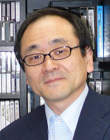
Ryoichi Matsuno [profile]
Education Course
Testimony of A City of Sadness- Taiwan's 228 Incident and Chuo graduates
Ryoichi Matsuno
Professor of Media and Journalism Studies, Faculty of Policy Studies, Chuo University
What happened in Taiwan after the end of Japanese rule?
A City of Sadness (1989, directed by Hou Xiao Xian), starring Tony Leung, premiered soon after the lifting of martial law in Taiwan (1987), and won the Grand Prix at the 1989 Venice International Film Festival. The reason this film sent shock waves around the world is because it depicted the historical facts of what happened in Taiwan after the end of Japanese rule.
After Japan's defeat in the war, the Chinese Nationalist Party (CNP) from the Chinese mainland had given the Taiwanese people hope for the building of new Taiwan. However, rule under the CNP was even worse than that under the Japanese. There was an inexplicable amount of corruption among government officials, rice and sugar being sold on the black market on the mainland, and lack of public spirit, and the Taiwanese people described it as like "dogs being replaced by pigs." This was used in the sense that the Japanese were nuisances but like a guard dog. However, the CNP only devoured greedily and weren't useful for anything.
The 228 incident occurred amidst this widespread discontent. On February 27, 1947, a Taiwanese woman selling illegal tobacco in Taipei was attacked by a Monopoly Bureau officer. The officer fired on the people who were causing a commotion and one youth died. In protest of this, a demonstration was held at the city hall the following day on February 28. Because the military police fired upon this protest, the conflict soon spread throughout Taiwan. The civilians temporarily grasped power in many regions, but the CNP government brought in reinforcements from the mainland, and oppressed the uprising with military force. According to the Executive Yuan 228 Incident Report, casualties were estimated to be 18,000 - 28,000 (other reports state these figures to be between 800 and 100,000).
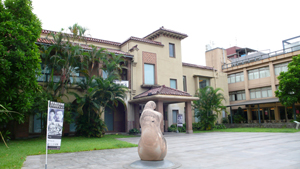
Photograph 1: The former Taipei radio station which rallied people during the 228 Incident. It is now the Taipei 228 Memorial Museum.
Why is a Chuo University's student cap on display?
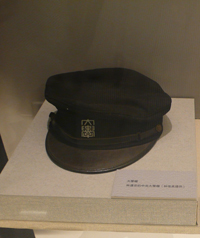
Photograph 2: Chuo University's student cap on display at the Taipei 228 Memorial Museum
About a 10-minute walk to the south from Taipei Station is a building called the Taipei 228 Memorial Museum. This was originally a radio station (Taipei Broadcasting Corporation in prewar times.) During the 228 Incident, civilians occupied this building and used it as a place to broadcast rally cries around all of Taiwan. I visited this museum in September 2012 on unrelated research. There, I noticed a Chuo University's student cap on display. What relationship did Chuo University have with the 228 Incident?
Actually, among the people who were executed or went missing in the 228 Incident, there were many elite Taiwanese who had studied at Japanese universities. People who had studied at, not only Chuo University, but also the University of Tokyo, Waseda University, and Nihon University etc., and became lawyers and doctors on their return to Taiwan, were executed as dissidents who were deemed to have been poisoned by Japanese imperialistic education.
Search for the family and owner of the student cap
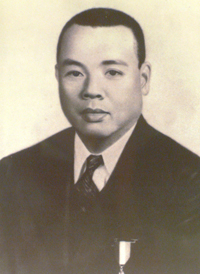
Photograph 3: Lin Lian Zong, who disappeared after being taken away by CNP military police
Who did this student cap belong to? The following was written on the display.
Lin Lian Zong. Born in Changhua City, Taiwan. Studied in the Faculty of Law, Chuo University in 1925, and passed the Examination of High Civil Servants in Law (National Bar examination) while he was there. He opened a law office on return to Taiwan. In 1945 he was elected as President of the Taiwan Bar Association, member of the Taiwan House of Councilors, and representative of the Constitutional National Meet. In order to attend the 228 Incident Management Council which was set up to deal with the 228 Incident in 1947, he travelled to Taipei from his home in Taichung. After the council ended on March 10, he headed for Taipei Station to go home, but the train had been stopped amid the confusion. Because of this, he visited a fellow graduate in the Faculty of Law, Chuo University Li Rui Han, who had opened a law firm in Taipei, to stay the night. Lin Lian Zong, Li Rui Han and his younger brother Li Rui Feng, who was also a lawyer, were having dinner together when several CNP military police officers came and took the three away. Nothing was heard of them after that.
The student cap on display, which can also be said to be a memento, was recorded as being donated by Lin Xin Zhen. Also, the donor's address was noted as Free Road No. 4, Taichung. I thought that if I followed up on this exhibit, I might be able to learn something of 228 Incident victims Lin Lian Zong and the donor, Lin Xin Zhen, as well as brothers Li Rui Han and Li Rui Feng.
Along with my seminar students, we first decided to search for the donor of the cap, Lin Xin Zhen. Investigations were tough, but one seminar student discovered the existence of a Japanese researcher who kept contact with Li Rui Han's son. We found out that it was Professor Yoichi Nakagawa of Faculty of Economics, Chuo University, who had exchanges with Li Rui Han's son, Li Rong Chang (80). It is truly hard to see what is under your nose. We had him introduce us to Li Rong Chang, and from there we were able to find our way to Lin Xin Zhen. Then we found out that Lin Xin Zhen was a female.
Testimony of Lin Xin Zhen by herself
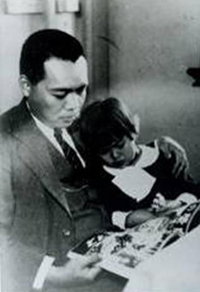
Photograph 4: Lin Lian Zong (left) and his only daughter Lin Xin Zhen
The morning of December 26, 2012, in the office of a Taipei travel agency, International Tour Operation (Zhang Gan Nan: President), I managed to have an interview with Lin Xin Zhen. President Zhang was also a victim of the post 228 Incident White Terror era, and gave accommodation to our investigations. Although Xin Zhen was in a wheelchair, she gave us a three-hour interview in Japanese, speaking clearly with crisp words.
She was an only child born on September 2, 1930, now aged 82. After spending six years at Xin Fu Primary School in Taichung, she entered Taichung First Girls' High School. She said she served as class president and gave solo performances at the school arts festival.
"My father was busy at work and was also travelling between the law office, local government law office and High Court in Taipei. But, because I was his only daughter, he showered me with much affection. We went to the zoo together, which was still a novelty at the time."
Then, in 1947, when she was 16, the 228 Incident occurred. In order to attend the 228 Incident Management Council which was set up on March 1 to deal with the incident, Lin Lian Zong travelled to Taipei from Taichung. Xin Zhen related the following about the last time she parted with her father.
"My father said to me, "Be good. I'm off now," so I replied, "See you later," and saw him off. That was the last time I saw him. I never thought that I would never see him again and farewelled him normally. I regret that."
When the day for his return arrived, Xin Zhen, her mother and grandmother became worried when he didn't come home. At the time they received a call from Li Rui Han's wife, who told them that the three had been taken away by the military police. They searched for her father's whereabouts by submitting petitions and inquiring with judiciaries, police and administration, but he has remained unaccounted for even now.
"After the incident, our life was miserable. We had lost the mainstay of our family and struggled financially. Because there was no body or remains, we couldn't even make a grave. Because the White Terror era continued after that, we couldn't mention a word of the 228 Incident. There was the danger of myself, or those around me, being arrested, so we kept our silence for a long time."
At the end, Xin Zhen stressed, "Even now, I recall my father's face every day. I feel anger and sorrow. At 44 he was a good lawyer who worked hard. Why was he killed? I want the government to present the true facts and give an official apology."
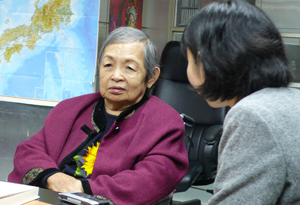
Photograph 5: Lin Xin Zhen being interviewed in Taipei by 3rd year student Shiho Fujibuchi, Faculty of Policy Studies
Eating squid rice gruel, even today
In the same way, a Chuo University Faculty of Law graduate and Taipei Bar association president Li Rui Han, and his brother Li Rui Feng, disappeared without a trace after being taken away. Li Rui Han's eldest son, Li Rong Chang, was a second year student at Taipei Municipal Jianguo Senior High School (formerly Taipei First High School) when his father was taken away by the military police.
"My father was strict, but he was a kind man. One day, when he boarded a boat for Japan at Keelung Port, he came across a person who had mistakenly boarded with a ticket for Hualien in Taiwan. I've heard that my father hastily asked for donations from the other passengers and handed the money to the man to ensure he wasn't suspected of any wrongdoing." "But after my father disappeared, our family lost our breadwinner and died away, falling further into poverty." One night when I woke up, my mother was crying. She was the type of person who would never cry in front of the children during the day."
The final dinner the three men were eating when they were dragged away by the CNP military police is said to have been squid rice gruel.
"They were taken away on March 10. So, on March 10 every year, wherever I may be, I have continued to eat squid rice gruel. Even when I worked in America, I turned down an invitation from a colleague and ate squid rice gruel by myself at home never to forget the incident."
Li Rong Chang, as a representative figure of the 228 Incident Family Association, continues today to work for human rights and call for the restoration of their honour. After the Great East Japan Earthquake he made a donation, whose sum was 2,280 Taiwan dollars.
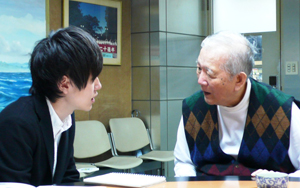
Photograph 6: Li Rong Chang (right) being interviewed in Taipei by 2nd year student Yohei Koda, Faculty of Law
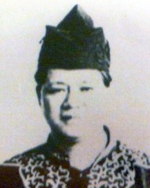
Photograph 7: Li Rong Chang's father and a lawyer, Li Rui Han
Following the footprints of Chuo University graduates
The number of Chuo University graduates caught up in the 228 Incident, through our investigations alone, stands at 10. However, that number, through further investigations, is bound to rise.
I want university students who go to Taiwan to not only travel, but definitely pay a visit to the Taipei 228 Memorial Museum. Taiwan under Japanese rule, the takeover of Taiwan by the CNP Army after Japan's defeat in the war, the CNP Army and the 228 Incident, confrontations between people from their own province and outsiders, the Chinese Communist Party and CNP, the CNP and the Democratic Progressive Party. I believe you can learn how Taiwan has continued to develop during such confusion and difficulties.
- Ryoichi Matsuno
Professor of Media and Journalism Studies, Faculty of Policy Studies, Chuo University - Born in 1956. Graduated from the Faculty of Education (Psychology Major) at Kyushu University. Completed a postgraduate course in education at the University of Tsukuba Graduate School. Ph.D. (Policy Studies) from Chuo University. He is in his present position after jobs as a city news reporter at Asahi Shimbun, a TBS producer. In 1996 to 1997, a visiting researcher at Harvard University (Fulbright Scholar). One of his research themes is about the relationship between news gathering activities and capacity development exercises. Furthermore, the Ryoichi Matsuno Seminar has to-date won a great many prizes. These include the Good Design Award, Podcasting Excellence Prize Award, The Age of Regionalism Video Festival Excellence Award, Hida Takayama Documentary Film Festival Grand Prize, Development Education/International Understanding Education Contest Foreign Minister Award, and the Tokyo Video Festival Tetsuya Chikushi Award. Every year, many of his seminar students start work in the media industry. His publications include Citizen Media Theory (published by Nakanishiya). He also supervised and edited Cultivation of Human Nature by Film Production (Taken Publishing), Our Elders Who Lived through the World War I and II, Human Behavior in the Digital Age and Citizen Media Activities (published by Chuo University Press). He has also translated Public Access Television: America's Electronic Soapbox published by Chuo University Press)
- Research Activities as a Member of Research Fellowship for Young Scientists (DC1), Japan Society for the Promotion of Science (JSPS) Shuma Tsurumi
- Important Factors for Innovation in Payment Services Nobuhiko Sugiura
- Beyond the Concepts of Fellow Citizens and Foreigners— To Achieve SDGs Goal 10 “Reduce Inequality Within and Among Countries” Rika Lee
- Diary of Struggles in Cambodia Fumie Fukuoka
- How Can We Measure Learning Ability?
—Analysis of a Competency Self-Assessment Questionnaire— Yu Saito / Yoko Neha - The Making of the Movie Kirakira Megane








